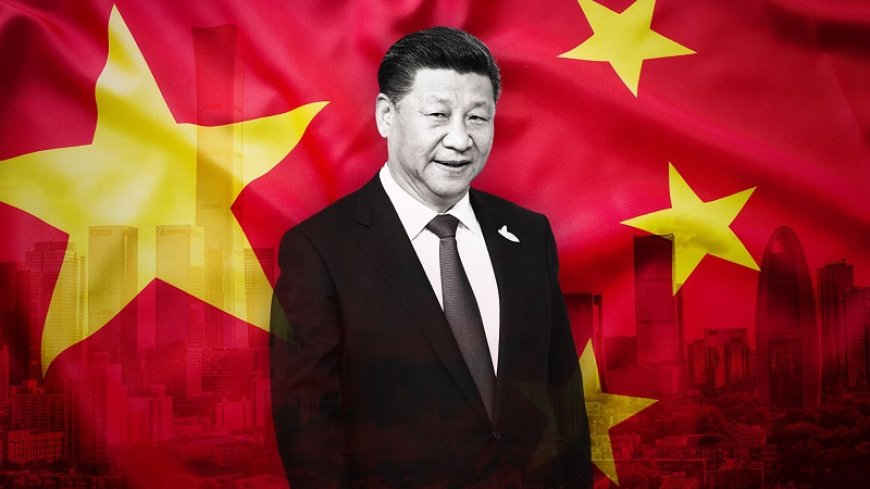China, undisputed leader of the world economy

The People’s Republic of China’s global investments have grown dramatically in recent years, surpassing the United States as the largest trading partner with many countries in Latin America and Africa and challenging America’s strategic influence across the globe. From official investments in key industries like infrastructure, aerospace, and power to investments by Chinese state-owned companies in new technologies like 5G, China has pledged to become a world economic leader by 2025 through global manufacturing. Under its “China Standards 2035” plan, China aims to set the global standards for the next generation of technologies, from telecommunications to artificial intelligence, a move that may have enormous implications for tech industries worldwide.
The COVID-19 crisis has highlighted China’s efforts to increase its global influence, from bilateral humanitarian response at the outbreak to vaccine diplomacy. China sent medical teams and donating medical equipment to over 150 countries and joined COVAX, the global initiative to ensure an equitable distribution of a vaccine, before the United States. Estimates indicate that China’s economy has already recovered from the downturn driven by the pandemic, growing by 4.9% in the third quarter of 2020, marking it as one of the few economies likely to show an overall positive rate of growth for 2020.
GROWING CHINESE INVESTMENTS IN DIPLOMACY AND DEVELOPMENT
Chinese President Xi Jinping released his vision for China’s global leadership at the 19th National Congress of the Communist Party of China, saying, “major country diplomacy with Chinese characteristics aims to foster a new type of international relations and build a community with a shared future for mankind.” In 2019, China surpassed the United States in the size of its diplomatic network, citing 276 diplomatic posts—including embassies, consulates, and permanent missions to international organizations. In 2018, China increased its budget for foreign aid by 7%.
Belt and Road. China is expected to spend over $1 trillion on its “Belt and Road Initiative” – seven times the size of the Marshall Plan in real dollars. This initiative seeks to build new markets for Chinese goods and increase China’s economic connectivity in 130 countries around the world, encompassing more than 60% of the world’s population and one-third of global GDP – including 40 out of 54 African countries.
- In the first half of 2020, China’s investments in the Belt and Road Initiative dropped by about 50% due to pandemic restrictions. Many countries announced they were postponing, cancelling, or reviewing Chinese-funded projects, including Egypt, Bangladesh, Pakistan, and Tanzania due to pandemic related internal economic concerns, as well as Nigeria or Myanmar whose own pandemic economic challenges may constrain their ability to service Belt and Road related debt later.
Chinese Development Institutions. In 2018, China launched a ministry-level development agency – the China International Development Cooperation Agency – to better coordinate and advance its commercial and foreign policy interests around the world through foreign aid. China also launched the Asian Infrastructure Investment Bank in 2014 which already has 103 member states, including many of America’s strategic allies.
- China does not participate in international coordinating agencies to ensure effective assistance like the OECD Development Assistance Committee. Many of today’s most pressing humanitarian crises receive little financial contribution from the Chinese government which has tended to focus on responding to one or two disasters annually.
Development Financing. Many have warned that China’s approach to development financing creates strategic dependencies by burdening a borrowing nation with enormous debt and using it as leverage, a tactic known known as debt-trap diplomacy, however, China’s approach to lending has evolved with time and experience. Recipient countries are expanding their negotiating power and procurement capacity, Chinese banks are willing to restructure the terms of existing loans, and multilateral institutions and great powers are playing a role in negotiations.
- While Chinese leader Xi Jinping says Chinese investments are meant to “embrace the historic trend of economic globalization,” many have left countries – including Djibouti, Ecuador, Kyrgyzstan, Mongolia, and Montenegro – at significant risk with large debts owed to China. These concerns have led countries such as Pakistan, Malaysia, Myanmar, Bangladesh, and Tanzania to scale back their commitments to the initiative.
Climate Change. China, a signatory of the Paris Climate Agreement, is also the world’s biggest emitter of greenhouse gases (almost equal to the United States, Europe and India combined). President Xi Jinping said China will “aim to have CO2 emissions peak before 2030 and achieve carbon neutrality before 2060,” and, according to the Chinese Ministry of Ecology and Environment, China reduced its “carbon intensity” by 18.8% between 2015 and 2020. At the same time, in the last three years, China has also allowed an extra 250 gigawatts of domestic coal-fired power plants and funds 1/4 of the world’s new coal-fired power plants in other countries.
CHINA’S GROWING ECONOMIC INFLUENCE AROUND THE WORLD
The Communist Party of China approved China’s 14th Five-Year Plan in March 2021, an economic roadmap with a goal of raising the country’s per capita output levels up to that of “moderately developed countries”—nearly three times the 2020 level—by 2035 such as Spain or South Korea, through an expansion of the state’s role in the economy, dual circulation, and secure supply chains.
Trade Deals: China’s entry into two new trade deals, one with 15 Asia-Pacific countries and one with the European Union, signals its commitment to set global standards for trade and furthers Beijing’s image as the dominate economic power in the world.
- Regional Comprehensive Economic Partnership, a 15-country trading block in the Asia-Pacific region, unites China, Japan and South Korea in a trade deal for the first time and includes 10 Southeast Asian countries plus Australia and New Zealand – a population of 2.2 billion people, almost 1/3 of the world’s population.
- Comprehensive Agreement on Investment binds China and the European Union to their current levels of market openness for investments and prevents potential rollbacks, with the possibility enhanced EU market access in China, in sectors such as health services, chemicals, electric vehicles, and telecoms.
Technology: “China Standards 2035” creates a path for China’s government and leading technology companies to increase the number of Chinese standards that become international standards for emerging technologies like 5G internet, the “Internet of Things” applications for manufacturing, and artificial intelligence. China aims to advance its digital infrastructure and domestic rules globally, which has raised concerns about the ways in which it deploys and exploits technology.
- Huawei, the largest telecommunications equipment manufacturer in the world with an annual revenue of US$108.5 billion, has been banned in 13 countries, with 19 countries weighing a ban or chosen competitors due to undue Chinese state support, links to the People’s Liberation Army, and cybersecurity concerns..
- President Xi announced that new energy technologies, such as car batteries from state-owned enterprises, will enable half of the vehicles in China to be electric or fuel-cell powered, and half hybrid by 2035.
Latin America: China has invested $150 billion in the region since 2005, more than the combined lending from
the World Bank, Inter-American Development Bank, and the CAF-Development Bank of Latin America, of which 90% has been directed to four countries: Venezuela, Brazil, Ecuador, and Argentina.
- China has leveraged its influence to isolate Taiwan, America’s strategic ally, pressing Panama, the Dominican Republic, and El Salvador to cut ties with Taiwan.
Africa: China has increased its investments in Africa by more than 520% over the last 15 years, surpassing the U.S. as the largest trading partner to Africa in 2009 and becoming the top exporter to 19 out of 48 countries in sub-Saharan Africa. According to McKinsey, there are now over 10,000 Chinese firms in Africa with the potential to generate $440 billion in revenues by 2025.
- China’s Export-Import bank loaned nearly $67 billion to Africa in the 2000s, more than 500% of the combined World Bank loans of $12.5 billion and aims to loan more than $1 trillion on the continent by 2025.
Asia: China spent more than $48 billion on diplomacy and development across East Asia and the Pacific between 2000 and 2017, rewarding countries that support its foreign policy positions and buy its products.
- More than 95% of China’s investments – totaling $120 billion – have focused on infrastructure development in the region.
WHAT THEY ARE SAYING: CHINA’S GROWING GLOBAL INFLUENCE
U.S. Congress
- Senate Foreign Relations Committee Chairman, Bob Mendez (D-NJ): “This moment demands a strong, strategic response that can begin to rebuild American leadership and invest in our ability to out-compete China in the generation ahead.”
- Senate Foreign Relations Ranking Member, James Risch (R-ID): “As we proceed through the 21st century, China is going to be a major competitor of ours in every way that there is. Obviously economically and militarily, culturally and every other way.”
- House Committee on Foreign Affairs Chairman, Gregory W. Meeks (D-NY): “China has used floods of high-quality industrial investment from Hong Kong, Taiwan, Japan, Korea and Singapore to become a center of world manufacturing. These are structural changes that will not be reversed; rather, they are likely to accelerate. And while the US needs tough policies to prevent financial manipulation and enforce American rights as they proceed, our response to the two giants must rest fundamentally on a willingness to recognize their accomplishment and a determination to match it.”
- House Committee on Foreign Affairs Ranking Member, Mike McCaul (R-TX): “With the emergence of China’s Belt and Road Initiative and their coercive lending practices, we must make it easier for our businesses to have access to foreign markets…Our diplomatic personnel on the ground in these countries and have unique insights on their political and economic complexities. We must do more to use this information to help the private-sector do business abroad and support U.S. foreign policy in upholding global stability.”
The Biden Administration
- President, Joseph Biden: “American leadership must meet this new moment of advancing authoritarianism, including the growing ambitions of China to rival the United States. We’ll confront China’s economic abuses; counter its aggressive, coercive action; to push back on China’s attack on human rights, intellectual property, and global governance.”
- Secretary of State, Antony Blinken: “Where we pull back, China fills in and then they’re the ones writing the rules and setting the norms of these institutions; standing up for our values when China is challenging them, including in Xinjiang against the Uyghurs or democracy in Hong Kong; making sure that our military is postured so that it can deter Chinese aggression; and investing in our own people so that they can fully compete.”
- Secretary of the Treasury, Janet Yellen: “The Biden administration will engage in a whole-of-government approach to China that uses our available tools in a manner that is designed to achieve our economic, national security, and foreign policy goals. Going forward, we should strive to meet this important challenge by building a united front of U.S. allies and partners, including through multilateral institutions, to confront China’s abusive behaviors.”
National Security Leaders
- Admiral Philip Davidson, Commander, United States Indo-Pacific Command: “We have to move out in the diplomatic and the information space, as well as the economic space, quite briskly because China is spreading dollars around very perniciously through corruption, through the mechanisms that you talked about earlier, and we’ve got to be willing to work in these other realms.”
ADDITIONAL RESOURCES
The USGLC held a virtual event with Senator Mitt Romney (R-UT) on the importance of America’s diplomacy and development programs to addressing competition with authoritarian governments like the China Communist Party: According to Senator Romney, “The way we win long-term against China is to have people of the world understand what’s happening there and encourage them to clamor for freedom and democracy—which is why America’s role on the world stage is critical. We need to put a strategy in place that uses our tools of influence—including diplomacy and development—to strengthen our alliances and partnerships and dissuade China from the course they are on to become a responsible member of the international community.”
- WATCH the discussion and learn more here.
The USGLC’s Report on Reports analysis of more than 120 think tank analyses across the political spectrum found broad agreement on the importance of combating rising authoritarianism but reflected different approaches to the challenge. READ the full analysis here, which found several areas of widespread consensus in reports across the political spectrum including strengthening the tools to combat election interference and disinformation, coordinating with allies on China and Russia, bolstering digital technology standards, and elevating human rights.
Source: https://www.usglc.org/










